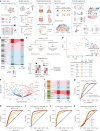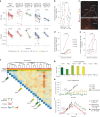Identification of clinically relevant T cell receptors for personalized T cell therapy using combinatorial algorithms
- PMID: 38714897
- PMCID: PMC11919687
- DOI: 10.1038/s41587-024-02232-0
Identification of clinically relevant T cell receptors for personalized T cell therapy using combinatorial algorithms
Erratum in
-
Author Correction: Identification of clinically relevant T cell receptors for personalized T cell therapy using combinatorial algorithms.Nat Biotechnol. 2025 Mar;43(3):445. doi: 10.1038/s41587-024-02318-9. Nat Biotechnol. 2025. PMID: 38918618 Free PMC article. No abstract available.
Abstract
A central challenge in developing personalized cancer cell immunotherapy is the identification of tumor-reactive T cell receptors (TCRs). By exploiting the distinct transcriptomic profile of tumor-reactive T cells relative to bystander cells, we build and benchmark TRTpred, an antigen-agnostic in silico predictor of tumor-reactive TCRs. We integrate TRTpred with an avidity predictor to derive a combinatorial algorithm of clinically relevant TCRs for personalized T cell therapy and benchmark it in patient-derived xenografts.
© 2024. The Author(s).
Conflict of interest statement
Competing interests: V.Z. is a consultant for Cellestia Biotech. G.C. has received grants or research support from or is a coinvestigator in clinical trials by Bristol-Myers-Squibb, Celgene, Boehringer Ingelheim, Tigen, Roche, Iovance and Kite. G.C. has received honoraria for consultations or presentations from Roche, Genentech, BMS, AstraZeneca, Sanofi-Aventis, Nextcure and GeneosTx. G.C. has patents in the domain of antibodies and vaccines targeting the tumor vasculature as well as technologies related to T cell expansion and engineering for T cell therapy. G.C. receives royalties from the University of Pennsylvania. S.B., G.C. and A.H. are inventors in technologies related to T cell expansion and engineering for T cell therapy. R.G is inventor on a patent related to TCR sequencing. A.H., R.P., V.Z., M.A.S.P. and G.C. are inventors on patent applications filed under certain subject matters disclosed herein. The remaining authors declare no competing interests.
Figures







References
-
- Rohaan, M. W. et al. Tumor-infiltrating lymphocyte therapy or ipilimumab in advanced melanoma. N. Engl. J. Med.387, 2113–2125 (2022). - PubMed
-
- Chiffelle, J. et al. Tumor-reactive clonotype dynamics underlying clinical response to TIL therapy in melanoma. Preprint at bioRxiv10.1101/2023.07.21.544585 (2023).
MeSH terms
Substances
LinkOut - more resources
Full Text Sources
Medical

